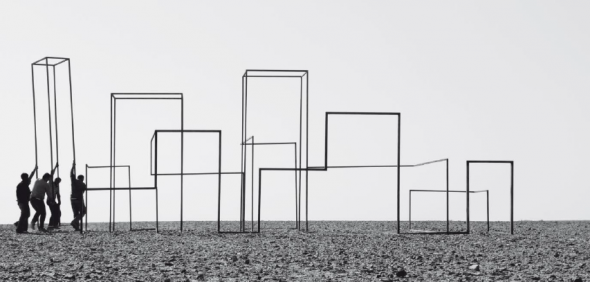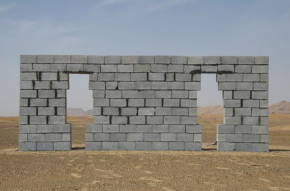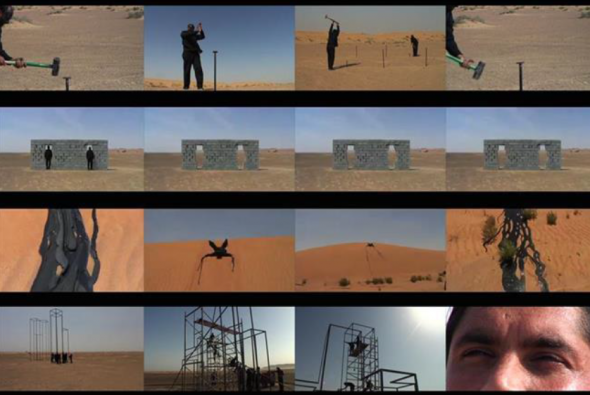A city called mirage by Kiluanji Kia Henda
Kiluanji Kia Henda was in the south of Angola when, crossing a city almost engulfed by the sands of the Namib desert, he noticed a rusty metal signboard on which the word ‘Miragem’ (Mirage) was written. The word, eaten away by time, suddenly became a symbol – something extremely concrete and abstract. The photograph of that signboard would come to be the starting point for a series of pieces of work that formed a city called Mirage.
If there is one city which synthesises the illusory aspect of a mirage, it is Dubai. At once a pastiche and a microcosm, a model and a parody, a diagram and a mirage, Dubai is omnipresent. It is no coincidence that in various media one speaks of ‘Dubaization’, a reference to a series of urban phenomena based on a spectacular and virtual style of architecture with no attachment to the particular territorial context in which it is planted. This is an architecture which fills in seas, flattens hills and demolishes historic buildings to create urban projects commissioned over the internet, just like in Luanda, the artist’s home town.
In A city called mirage, Kia Henda deals with the absence of dividing lines between the real city and its 3D model. The work exhibited at the Galeria Filomena Soares cannot be clearly categorised. It consists of photographs and sculptures, performance art and video, fictional texts and documentary record all in one. It is more akin to a diagram than representation per se, since there is no distinction between expression and content.
 Rusty Mirage (The City Skyline), 2013. Impressão a jacto de tinta sobre papel de algodão
Rusty Mirage (The City Skyline), 2013. Impressão a jacto de tinta sobre papel de algodão
The best examples of this multiple focus are Rusty Mirage (The City Skyline) – photographs of sculptures created in the Al Zaraq desert in Jordan – and the series Buildings (The Palace, The Fortress, The Temple, The Ministry) – silk-screen prints and photographs of sculptures created in the Maleha desert in Sharjah. The sculptures in the shape of metal lines look like drawings standing out from the landscape, silhouettes or skeletons of an imaginary city. Kiluanji based these linear sculptures on sona, sand drawings common to the Lunda Tchokwe culture (from eastern Angola). Storytellers draw the sona (plural of ‘lusona’) in the sand as they tell fables. These drawings are authentic narrative constructs which condense the outline of the story told. Kia Henda transforms these ephemeral drawings into three-dimensional objects, imaginary structures in the desert. But unlike the Tchokwe, Kiluanji’s diagrams trace virtual future stories unconnected to the past.
Next, and in counterpoint to the transparency and grandeur of Rusty Mirage and the series Buildings, arranged on a table is Instructions on How to Create Your Own Personal Dubai at Home. These are instructions and images of megalomaniacal works of architecture built from simple everyday objects: a Palm Island made of matches, a Burj Khalifa (the world’s tallest building) made of beer cans, and an undersea bedroom made of cling film. And the parody stems from the various possible interpretations. In the megalopolis, capital creates the world in its own image and likeness. Like all merchandise, cities are customised and disposable. This mass customisation is added to the production of sensory spaces. Architecture suddenly becomes a drug which bestows a ‘ hallucination of normality’.
In Settings for an Imaginary Landscape, four photographs of inorganic materials are used to construct a road in Namibia. What comes before is indistinguishable from what comes after: what is about to be used to build with already looks like it is ruined. The matter removed from below the surface and arranged in heaps seems to be part of the landscape. It is as if the underground matter has expanded on the surface. Could a repositioning of solids like this be capable of changing the Earth’s axis or causing planetary collapse?
But if the city consumes the planet, it also consumes itself. The video Mission films workers removing the remains of a demolished building on a busy road on the outskirts of Luanda. By dumping the lorry’s rubble into a mud pool, it is as if the men are freeing themselves from a corpse building.
 Compacted Distance, 2014. Impressão a jacto de tinta sobre papel mateIn the same section of the exhibition is Compacted Distance, a photograph of a wall with two voids shaped like people. We see the landscape in the background through the two holes. Like a photographic negative, we are in the presence of an absence, the mark left by a past event. The wall is a fossil.
Compacted Distance, 2014. Impressão a jacto de tinta sobre papel mateIn the same section of the exhibition is Compacted Distance, a photograph of a wall with two voids shaped like people. We see the landscape in the background through the two holes. Like a photographic negative, we are in the presence of an absence, the mark left by a past event. The wall is a fossil.
Finally, in the projection room, a video installation produces a synthesis of the exhibition. Both performance and sculpture, video installation and land art, Paradise Metalic tells the story of a man who tries to build an ideal city seen in his dreams. Identifiable in this video is a reference to the architectural culture of Islam which seeks to construct paradise by using geometric patterns: no other religion places as much trust in geometry as Islam.
For a year, Kiluanji took part in an international project in which he produced and collaborated with architects, artists, actors, musicians and technicians from cities like Amman, Dhaka, Karachi, Lisbon, Luanda, Manila, New York, Paris, Rio de Janeiro, Sharjah and Windhoek. A City Called Mirage is a complex exhibition which explores original approaches to a recurring theme in recent times: that of cities between the states of virtuality and desertification. Kiluanji uses (science and mythological) fiction and irony as ways of transcending the pessimism of hyper-criticism and the aesthetics of the ruin. Through humour we are made aware of just how ephemeral the largest human constructions are: all cities will be reduced to raw materials again, just like the metals removed from the ground will once again merge back into it.
 Paradise Metalic, 2014. Vídeo em 4 canais sincronizados | 4 multi-channel synchronized video 23’ (loop)
Paradise Metalic, 2014. Vídeo em 4 canais sincronizados | 4 multi-channel synchronized video 23’ (loop)
A City Called Mirage can be seen until 29 November 2014, at Galeria Filomena Soares: Rua da Manutenção – 80 | 1900-321 Lisbon | Portugal | T_ +351 218624122 / 23 | F_+351 218624124